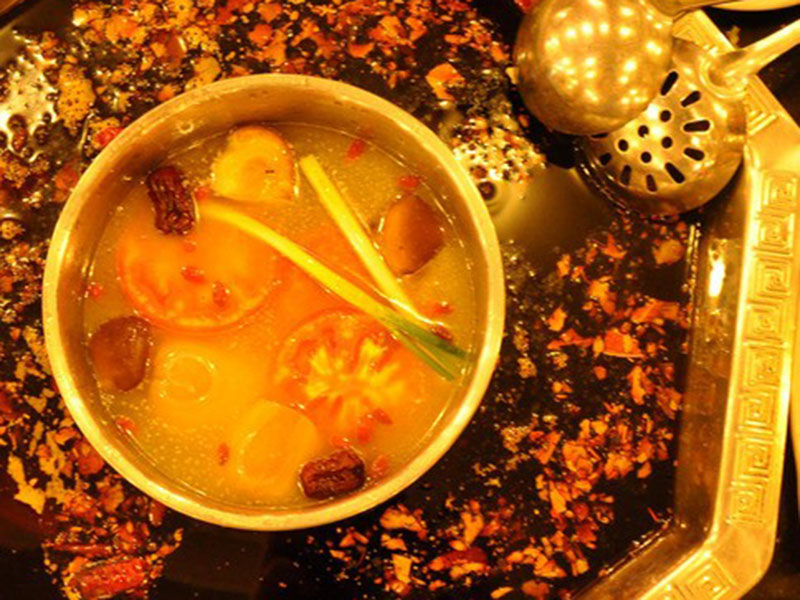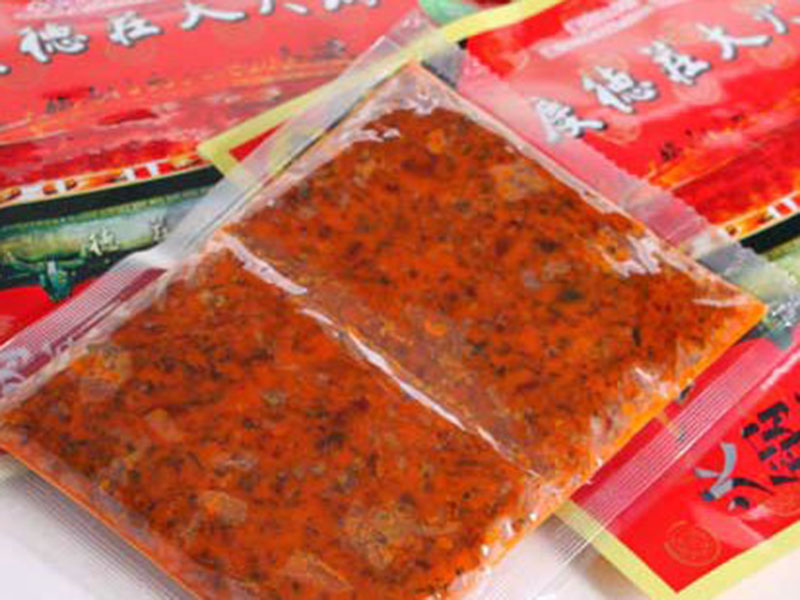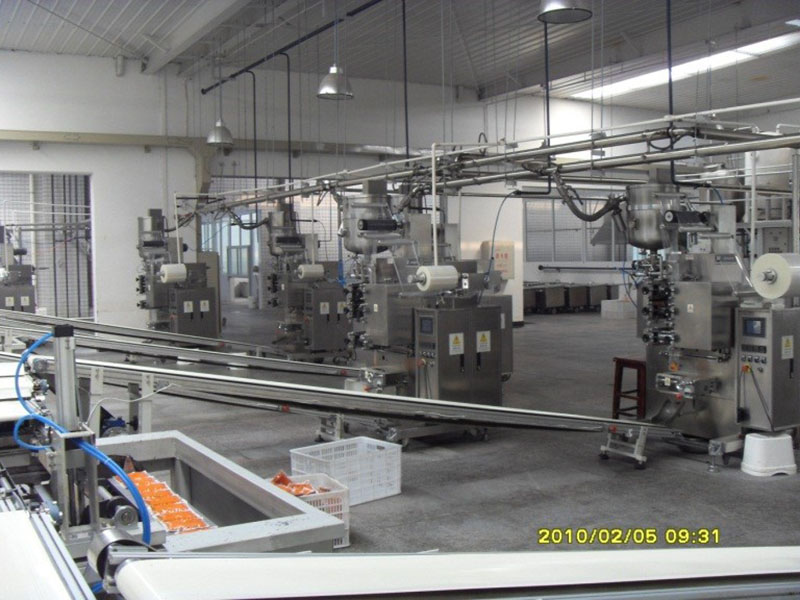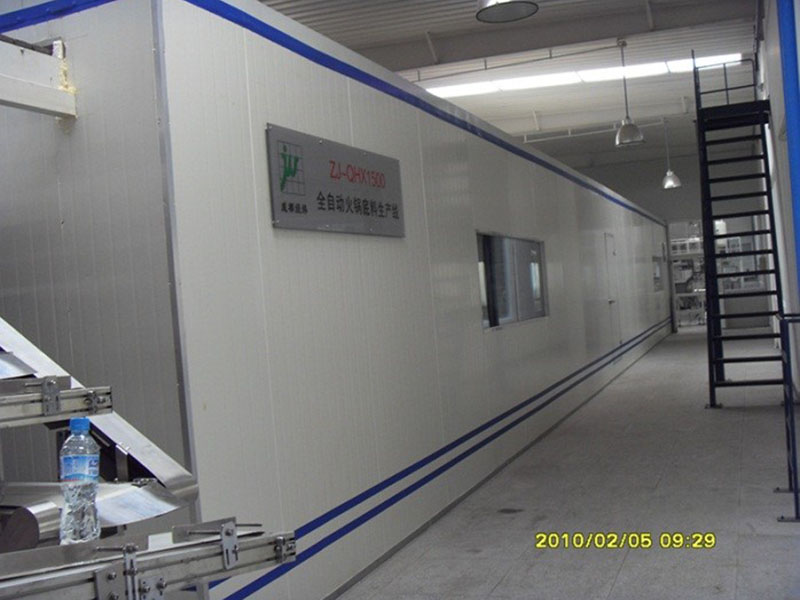Seasoning Product Case – Hot Pot
As is well known, Sichuan and Chongqing are renowned for their culinary civilization, and hot pot is an indispensable part of Sichuan and Chongqing cuisine. For many years, the production of hot pot in Sichuan and Chongqing has mainly relied on manual workshops, which has brought about many issues such as food safety and low efficiency due to labor-intensive processes. In 2009, E&W Company, located in Chengdu, began assisting well-known hot pot manufacturers in Sichuan and Chongqing to develop the first automated production line for hot pot in China, filling the gap in this industry. This production line realizes the industrialization of the entire process, including the handling, frying, filling, oil extraction, cooling, shaping, and packaging of ingredients such as chili peppers, ginger, garlic, and others. It effectively cools the filled hot pot from 90°C to 25-30°C and automatically seals it in outer packaging. The system can accommodate package weights ranging from 25 grams to 500 grams.


In 2009, our Jingwei machine independently developed, designed, and produced the first automated production line for hot pot in China for Chongqing Dezhuang Agricultural Products Development Co., Ltd. Subsequently, E&W Company has provided a total of 15 production lines to various companies, including Chongqing Zhou Jun Ji Hot Pot Food Co., Ltd., Sichuan Dan Dan Seasoning Co., Ltd., Chengdu Tianwei Food Co., Ltd., Chengdu Xiaotian'e Hot Pot Food Co., Ltd., Xi'an Zhuyuan Village Catering Food Co., Ltd., and Sichuan Yangjia Sifang Food Development Co., Ltd. These production lines have assisted the above-mentioned companies in smoothly transitioning from manual workshop-style operations to industrialized and automated processes.
During the design and development process of this hot pot production line, there have been numerous breakthroughs in design and innovation.

1. Automatic filling: In the traditional method, material conveying, weighing, filling, and sealing were all done manually. However, manual handling of the packaging material posed direct concerns for food safety. Additionally, manual packaging required high precision and involved a significant amount of labor, making it the most labor-intensive part of the process. Currently, the processed ingredients are transported through pipelines to temporary storage tanks, and then pumped into the vertical filling packaging machine through a diaphragm pump for volumetric measurement. The material is then discharged, and continuous heat sealing with rollers forms the inner packaging of the hot pot. This isolates the material from the operators, effectively ensuring food safety.
2. Automatic bag placement and oil extraction: In the traditional method, workers manually placed the inner bags of the hot pot on a flat surface and manually slapped the bags with their palms to ensure that the butter floats on top of the dry ingredients, enhancing the visual appeal of the product. This requirement is a common process in the hot pot industry. To meet this specific requirement, we have designed a series of shaping and oil extraction devices that imitate the slapping action, closely replicating the effect of a human palm. This process significantly improves efficiency, achieving a 200% increase. This innovative design point has obtained two utility model patents in China.
3. Automatic cooling: After the butter-filled inner bags are sealed, their temperature is approximately 90°C. However, the subsequent process requires the outer packaging to be cooled to at least 30°C. In the traditional method, workers manually placed the bags on multi-layer trolleys for natural air cooling, resulting in long cooling times, low output, and high labor costs. Currently, the production line utilizes refrigeration compression technology to create a cooling room. The conveyor belt automatically positions the hot pot inner bags, which then move up and down inside the cooling room on a conveyor board, ensuring efficient cooling. Moreover, the tower design structure maximizes the utilization of vertical space, saving floor space for customers. This inventive design point has obtained a national invention patent.

4. Outer packaging and boxing: In traditional practices, manual outer packaging and boxing involved entirely manual operations. One line required the involvement of nearly 15 people for turnover and arrangement. Currently, industrialized production has achieved almost unmanned operations. Human intervention is only necessary to ensure the smooth operation of the equipment and perform quality checks on the products, significantly saving on labor. However, highly industrialized equipment demands a higher level of personnel qualifications compared to the original labor-intensive requirements. This is also the cost that enterprises need to bear when transitioning from workshop-style operations to industrialization.
The above four points are the main characteristics of this production line. It is worth mentioning that each production line is customized based on the different requirements of each manufacturer regarding the hot pot process. The frying and cooling stages directly impact the texture and taste of the hot pot product. During the design process of the production line, the essence of the traditional workshop form is preserved to the greatest extent. After all, having a distinctive texture and taste is the foundation for hot pot enterprises to establish themselves in the market. In the process of transitioning to industrialization, the standardized operation of the production line does not make the enterprise lose its uniqueness. Instead, it provides numerous advantages in ensuring food safety, reducing labor costs, improving production efficiency, and implementing standardized management in the intense market competition.
Jingwei Machine has gone through a similar process of industrialization in the hot pot industry and has also experienced the localization of equipment for numerous food enterprises. Our accumulated experience has been transformed into strength, and we have confidence in providing customized solutions for more industries and customers in China, assisting the condiment and food industry, and even a broader range of industries, in transitioning to industrialization.
Post time: Jun-15-2023


